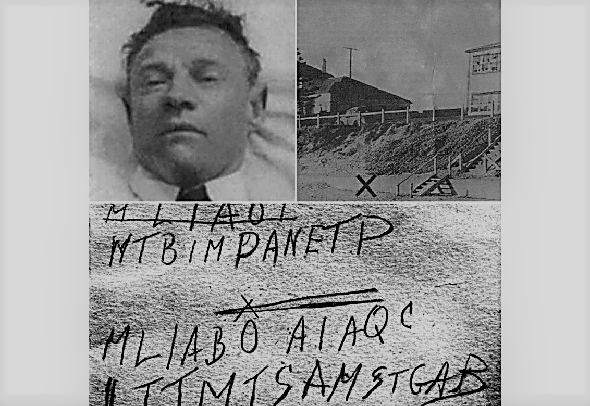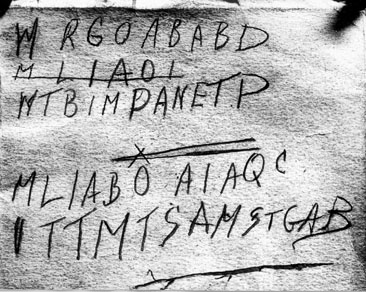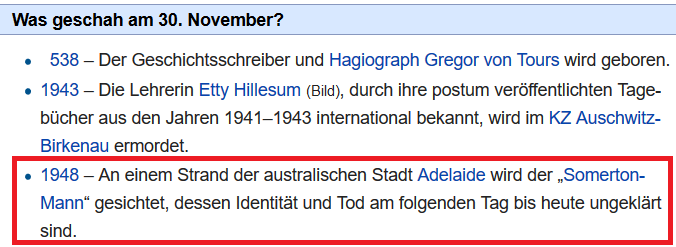An alleged cryptanalyst has published a new hypothesis about the Somerton Man cryptogram on Wikipedia. Does it make sense?
Reports about the Mystery of the Somerton Man (also known as the Tamam Shud case) often start with a sentence like the following: “On 30 November 1948, an unknown man was seen by witnesses on Somerton Beach in Adelaide, Australia, …”. As you might have noticed, this means that last Friday it was exactly 70 years ago that the Somerton Man was spotted. Yesterday was the unknown man’s 70th death anniversary.
Such an anniversary would be a good occasion to remember that the dead man who was found 70 years ago …
… is still unidentified to date and that the encrypted (?) note he carried with him …
… has never been deciphered. However, this is not the purpose of this post.
It is also not the purpose of this post to tell you that the German Wikipedia had a link to the Somerton Man entry on its title page last Friday (though I am a little proud that a book and an article of mine are referenced in this entry).
The actual reason for my post is that I learned something new when last Friday I read the German Somerton Man entry on Wikipedia. Here is the paragraph that caught my eye:
Here’s a translation:
In October 2018, for the first time the consideration arose that the message could have been created on the basis of a previously learned, greatly reduced dictionary. If this dictionary is known to both the sender and the recipient, it is possible to substitute each individual word of the cipher with a different key alphabet. By means of the arrangement of letters (‘word patterns’), the recipient can nevertheless identify the plaintext on the basis of the word list available to him. In the case of English, there are approximately the following (few) possible solutions:
A TRAINING CONSERVATOR ABDUCT ENEMY SEEK RENDERING
A TRAINING DEMOGRAPHER DANGER ENEMY ASSIST ADMIRAL
A TRAINING CONSERVATOR ABDUCT ENEMY ERROR ONCOMING
A TRAINING DEMOGRAPHER DANGER ENEMY DEEPEN ANTIWAR
A TRAINING CONSERVATOR ABDUCT ENEMY LOOKOUT KELVIN
It can be taken as a confirmation of this method that there are very few alternatives to the words ‘A’, ‘TRAINING’ or ‘DEMOGRAPHER’ (these alternatives are not necessarily on the word list). Another special feature is that the last two words are always combined for tactical reasons, for example to make it more difficult for outsiders to recognize this relatively easy-to-understand encryption method. However, it is conceivable that the cipher was written in a language other than English.
The source for this hypothesis is described on Wikipedia as follows: “First discussed on October 3, 2018 by cryptanalyst Christof Rieber (‘sequential polyalphabetic substitution’)”.
It goes without saying that, after reading this, I asked myself a few questions:
- Who is Christof Rieber? Rieber is described on Wikipedia as a “cryptanalyst”. However, I have never heard of him and I can’t find anything he has published. I don’t know if he is identical with the person who has written a German Einstein biography.
- Does this hypothesis make sense? It is not impossible that the author of the Somerton Man cryptogram used a different substitution table for every word. However, in my view, there are two reasons why the Rieber hypothesis is most likely wrong. First, it would be unusual that somebody uses such a complicated cipher for such a simple note. And second, the letter frequencies clearly indicate that the letters of the cryptogram are starting letters of English words, which contradicts Rieber’s conjecture that we deal with a (polyalphabetic) letter substitution.
- Who wrote these paragraphs on Wikipedia? This question is easy to answer. I’m sure, it was Rieber himself.
- Does this hypothesis belong into a Wikipedia article? In my view, it doesn’t. Publishing “original research” (i.e., previously unpublished research results) on Wikipedia clearly offends against the Wikipedia rules. The remark “First dicussed on October 3 …” is not a literature reference. In my view, these paragraphs should either be deleted or complemented with a proper reference.
If you have a different opinion about this new Somerton Man hypothesis, please let me know.
Follow @KlausSchmeh
Further reading: A German spy message from World War 2
Linkedin: https://www.linkedin.com/groups/13501820
Facebook: https://www.facebook.com/groups/763282653806483/







Kommentare (20)